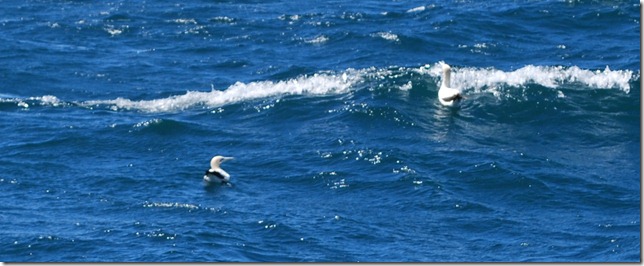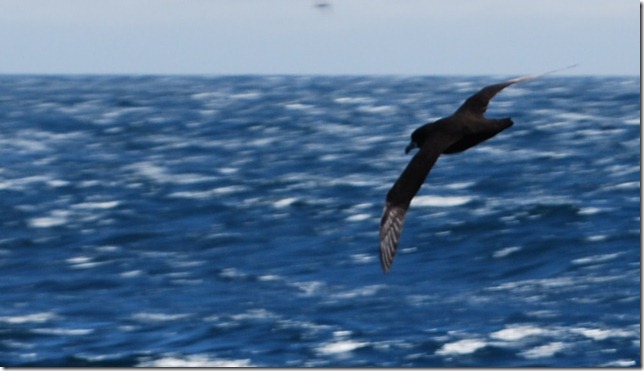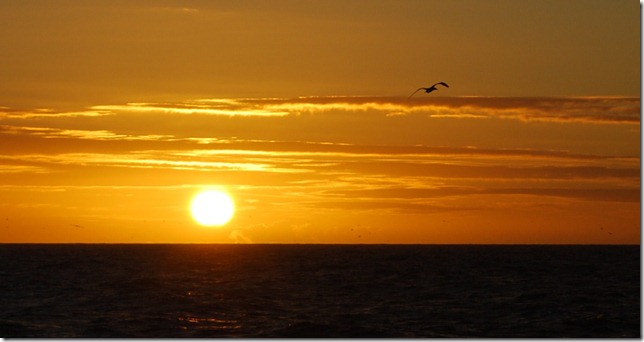I made it! I arrived nearly all in one piece, but unfortunately I didn’t get in without a little more excitement than I wanted.
Since leaving Durban, I’ve sailed nearly 800 nm, spending six nights at sea with just the one stop in East London. I really got lucky on the second weather window that let me sail the 530 nm from East London to Simon’s Town non-stop. It seemed to be an especially long window, the forecasting was excellent, and I was able to put together an approach to the passage based on the forecast that left me with a little motorsailing, but never having to deal with contrary winds or any really bad conditions.
Rounding the cape was a little anti-climactic. It was a cool feeling, but at the time I would gladly have traded it for a warm shower and a nap. Sailors always joke that anything with the word “Cape” in it means trouble, but although it was windy, and the seas were a bit rougher there, it was nothing like the harrowing stories of rounding the cape in a gale from the old days of tall ships. It also seemed a little strange sailing past it by myself. Voyaging around one of the world’s southern capes is still sort of a big deal for sailors, so it seemed a little strange to be doing it by myself when this trip has been such a joint effort. For me, it was a time to think about Wes and Lauren, the two people who have had the most to do with this trip. Wes and I learned to sail together back in Houston aboard our Catalina 30, he kept the dream alive with a string of great charter trips in Florida and the Bahamas after we sold our boat, and he partnered on this trip as well, sailing with us from the US to New Zealand. Lauren’s shared the dream (and the reality) of this trip since day one and I’m really looking forward to her return (only 2 more days now!).
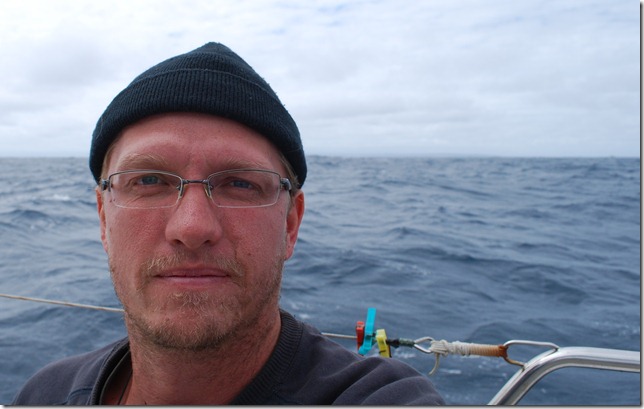 Rounding the southernmost point of the African continent – Cape Agulhas. This one’s dedicated to the original Pura Vida crew: Wes, Tiff, & Lauren.
Rounding the southernmost point of the African continent – Cape Agulhas. This one’s dedicated to the original Pura Vida crew: Wes, Tiff, & Lauren.
Just before rounding the cape, I crossed inside the main shipping lanes and headed farther inshore for the run up to False Bay. After that, I was free of shipping traffic, but closing with the coast also meant keeping an eye out for the shoreline, only a few miles away, and for several rocky banks. I had a chance to get a couple of hours of sleep by putting the boat on an offshore course that was well inside the shipping lanes, and two hours of sleep is like an eternity for me at this point. I woke up with so much energy that I cooked a meal, picked pictures for the blogs, did some emailing, and started writing this blog.
Unfortunately the energy from two hours of sleep doesn’t last forever. Right as I was entering False Bay and struggling to stay awake, the blow started. It must have gotten up to 30-40 knots and it was freezing cold – pants, two sweatshirts and my weathers still left me cold from the wind. The waves built as well, but I was able to roll the jib up and make 5-6+ knots on only a third of it. The cold helped keep me awake, but I was still tired enough that if I rested inside for more than 5 or 10 minutes I couldn’t keep my eyes open.
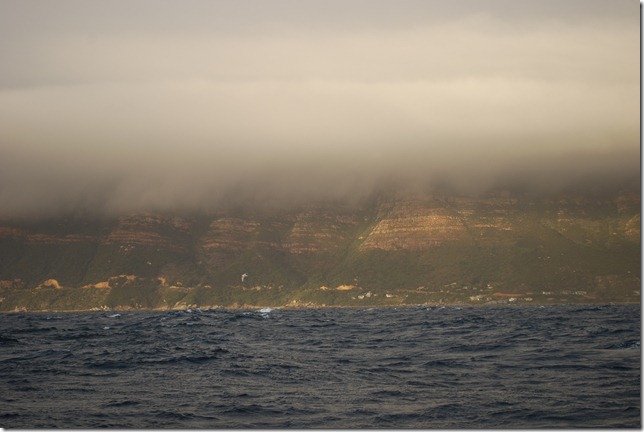 False Bay is a large, horseshoe-shaped bay open to the south and lined with rugged, mountainous terrain
False Bay is a large, horseshoe-shaped bay open to the south and lined with rugged, mountainous terrain
Everything went smoothly until it was time to furl the jib, start the engines, and come in. Right as I started rolling in the jib, it really started blowing – gusting over 40 knots. The port engine was slow to start in the cold, but eventually did. The starboard wouldn’t. With this much wind and a tricky spot to get into in the marina, I really needed both engines for maneuverability, so after several attempts to start the engine failed I headed down to the engine room. I figured it was just cold (we don’t have glow plugs) and there’s a good trick you can use if just heating up the cylinders by trying to start it doesn’t work. The problem is that you need one person to turn the ignition key (20 ft. away) and another to hold the decompression levers on all three cylinders until the engine is really spinning and then release the decompression levers, allowing the engine to fire. Luckily the ignition wire was conveniently set up for hotwiring, so I was able to hold the decompression levers and at the same time disconnect the ignition wire and manually short it to the +12V for the starter, sending sparks flying as the engine turned over, but on the second attempt it worked. I was pretty happy, because it was blowing a gale onshore, I’m not really set up for singlehanded anchoring, and I really wanted to get in and get some sleep and a shower.
Unfortunately, it was apparently a little early and nobody from the marina was answering the radio. Oh well, I figured I’d go ahead and go in and either flag someone down to help me with the docklines, do it myself, or turn around and go back out to wait. I did manage to flag down a confused but very helpful sailor named John, who had stuck his head out to have a smoke as I was coming in. The spot I had to get into was at the very beginning of the dock, next to a wall with other boats, with a strong tailwind, and for some reason, there was a mooring buoy floating right in the middle of the area between slips at that end, ready to foul the prop. Not exactly what I was hoping for, but I gave it a shot and came close. Unfortunately, it was a starboard side tie-up and we usually do port-side so that I can see the dock from the helm. Being unable to see the dock (and the dock having no corner protectors) I gave the starboard hull a pretty good scratch turning the corner. Oh well. Normally I’d be pretty bummed about it, but we should be able to get it sorted here and it’s not bad, all told for a passage from Durban to False Bay. So much for all the danger and excitement happening offshore.
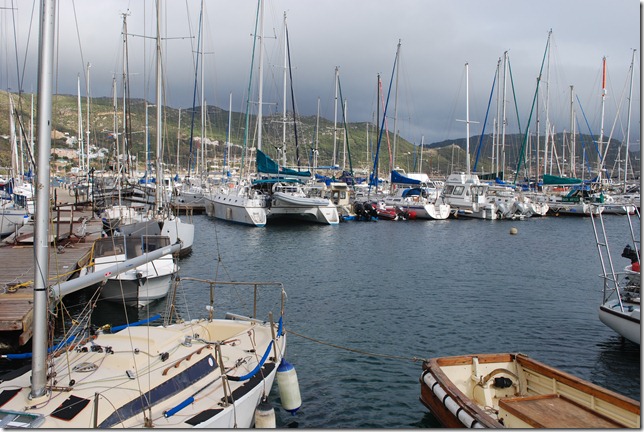 Doesn’t look tight from this angle, but sure felt that way with the wind howling, and why is there a buoy right in the way?!
Doesn’t look tight from this angle, but sure felt that way with the wind howling, and why is there a buoy right in the way?!
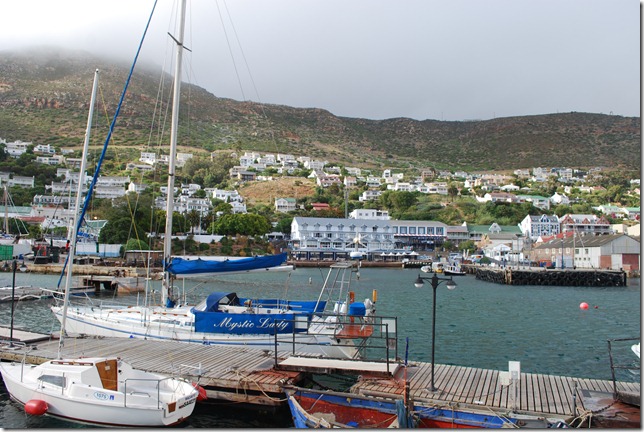 The quaint, colonial-looking waterfront ought to be fun to explore
The quaint, colonial-looking waterfront ought to be fun to explore
I didn’t mention it earlier, but we’re formally in the Atlantic Ocean now. Two down and one to go…
Lat: 35 07.137′ S
Lon: 20 43.302′ E
I didn’t think I’d have much to write about by myself out here, but I guess I was wrong. I’m emailing twice a day anyway to keep a close eye on the weather, so why not?
Last night was one to remember. There have been more seabirds here than anyplace we’ve been except maybe New Zealand. At sunset, they spread out over the ocean fishing for dinner. Hundreds of them, spaced well apart, covered most of the visible ocean surface. They fished by flying at a relatively low height, flying odd, swooping patterns at 50′ or less. When they spotted prey below, they immediately interrupted their flight with a direct dive down into the water. Sometimes they’d spotted something ahead and just nosed down into a dive, but at at other times the fish was beside or even just behind them and they turned into aerial acrobats, executing a quick combination of rolls, turns, and spins to point nose first at their target, then tucking their wings, they dropped with the force of gravity until they disappeared with a splash. As I sat watching them in the orange glow of the sunset, I could see the unmistakable plumes of spray from whales off in the distance.
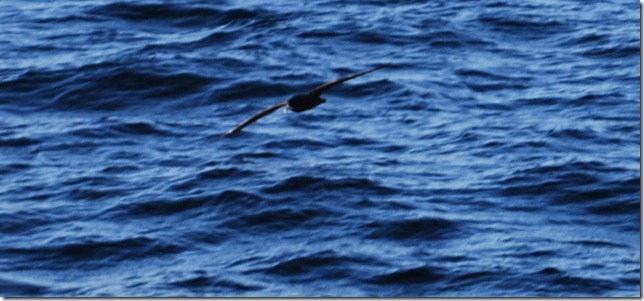 Some birds will dip a wing to skim the surface in order to scare or herd fish
Some birds will dip a wing to skim the surface in order to scare or herd fish
This far south during the southern winter the days are noticeably longer than in the tropics, and there was still a faint light from the sun left in the western sky at 9 pm. When it faded, and before the moon rose in the east, the sky was covered in a soup of stars. The Milky Way stretched across the sky and even common constellations were a little difficult to identify because of all the dimmer stars, normally masked by ambient light, that were shining brightly. Even 50 miles offshore, the water hasn’t turned blue here; it has a greenish hue and is rich with phosphorescent plankton. In the starry night, every whitecap or disturbance in the water became a glowing, frothy white. Behind me, the boat’s wake was two glowing streams of phosphorescence that stretched more than 60′. The hulls themselves created such a glow that it looked like that boat was made of fluorescent lights below the waterline. As we moved along through the crisp night air, it made me wish there was a way that you could capture a sight or an experience like this so that you could re-live it. But you can’t. All you can do is keep having new adventures.
Sailing is all about highs and lows — fighting not to puke while struggling to perform the basic necessities of life and sailing one day, and then staring in awe as you sit quiet and undisturbed the next day, taking in some of the planet’s most beautiful sights. Those highs and lows are a little more extreme when you’re singlehanding, but aside from the fatigue and loneliness, it’s much the same.
I just changed course and headed WNW for Cape Agulhas, about 40 nm away. The new northerly component will stay in our heading until we reach the US. It looks like I’ll round the cape in daylight today and reach Simon’s Town tomorrow.
Lat: 35 00.934′ S
Lon: 22 26.494′ E
Yesterday ended up being a pretty nice day weather-wise. The sun was out most of the day, seas were down, and it was cool, but not cold. Around dusk, the wind had dropped enough that boat speed was hovering around 4 knots, so I needed to do something. Normally I’d put up the spinnaker, but being singlehanded with night coming on, I decided to go for some motorsailing instead. The port engine had only been running a couple of minutes when I heard it start losing power, dropping RPMs, and beginning to die. I quickly shut it off, tried restarting it, and got the same result (not sure what I was trying to prove there). Off went the watch clothes, on went the work clothes, and I crawled down into the engine room with a headlamp. The transparent bowl at the bottom of the combination fuel/water and fuel filter had generous amounts of something that looked like mucus in it. I soon figured out that if I squeezed the manual pump fuel bulb I have in-line, more mucus-looking stuff would dump into the filter, but the engine would only run for a minute or two until I had to pump again, and it was starting to sound a little loud.
Ok. At least I know what’s wrong now — bad fuel and a clogged fuel filter. I’m usually pretty careful about fuel, but I have had a couple of incidents lately, with the port tank, that aren’t (or maybe are) characteristic of me. One was buying 5 gallons of fuel off Garth in Mozambique. He needed the cash and I could always use a little fuel, but I would normally only buy fuel from someplace I expected to have clean, fresh fuel. The second one was accidentally leaving the fuel fill cap off overnight after getting distracted while adding a jug of fuel in Durban near sunset. It sprinkled a little bit, but I don’t remember it raining too much.
Whatever the cause, I gave it up for the night and settled for 3-4 knots on the jib as the wind was too far aft to use the main. I didn’t want to run the other engine because one engine down is halfway to no engine at all, and I’d rather not push it. The effect of sleeping so little for a day and a half had caught up with me. Even with my watch being right beside my ear, it never woke me up once. I found myself waking up 1-3 times an hour, but never because the alarm was going off.
Luckily, the AIS seems to be working again, which makes things much safer. My current theory is that the problem was humidity messing up the AIS RF electronics, but we’ll see. I moved some canvas covers and rags that were getting wet so that now any moisture in that compartment drains out and it seems to have made a difference.
Here’s the basic math behind not getting run over (which did happen to a boat out here in the last year). Large ocean-going ships generally do 14-17 knots. Our speed is variable, but it’s not unusual to be doing 7 knots here due to strong winds or current. I’m essentially trying to cover the same route they’re covering, so they’re always coming up from behind or ahead. From behind, they’re closing at around 10 knots, which is slow enough for me to see them before anything can happen, but from ahead they’re closing at 24 knots or more sometimes. In good conditions (good visibility, calm seas, awake & alert person looking, and spending a bit of time looking and re-looking) you can spot the superstructure of a large ship at roughly 8-11 miles. Between 5-8 miles, the hull becomes visible, making it a much larger object on the horizon and one you’re not likely to miss. The issue is that at 24 knots, you’re getting a mile closer to each other every 2.5 minutes, or 6 miles closer between every 15 minutes check. It’s not uncommon to miss seeing a ship due to poor visibility, fatigue, a tanker’s low profile, etc. when it’s 6-8 miles away and then come back out 15 minutes later to find it right on top of you. If you miss one 15 minute check, a ship that wasn’t visible last time you looked can now be past you. This is where the AIS makes itself very useful. In addition to telling you exactly where each ship is headed and sounding an alarm if you’re on a collision course, it can see much farther than the naked eye, easily picking up ships 15-20+ miles out, giving you a warning time that’s much longer and letting you concentrate on the occasional ship that is going to pass close by instead of visually tracking every ship you see to determine whether it’s coming toward you. You can see why having it working again has been a big deal. The local fishing boats never seem to be fitted with an AIS transmitter, but they’re always well lit, generally aren’t moving too fast, and theoretically are keeping a good watch.
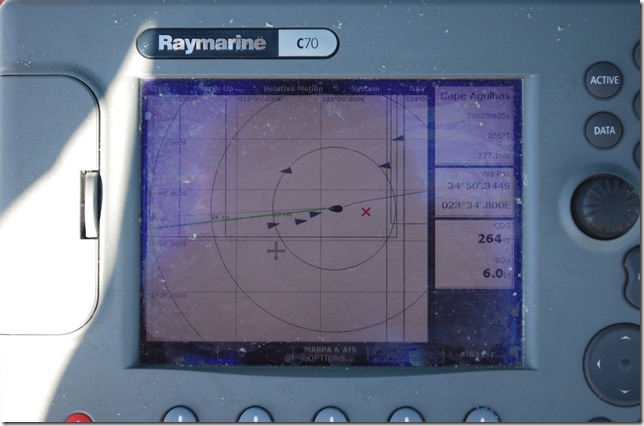 A common sight – half a dozen ships and three coming my way
A common sight – half a dozen ships and three coming my way
 For all the Hannibal, Palmyra, & Quincy folks – the Mark Twain loaded with containers the size of railway cars
For all the Hannibal, Palmyra, & Quincy folks – the Mark Twain loaded with containers the size of railway cars
After getting more sleep than anticipated, I was ready to tackle the port engine problem not too long after sunrise. I anticipated a lot of work filtering fuel, making a small clean-fuel tank from a jerry can, and bleeding the engine, but I started by draining the filter/separator and immediately saw the problem — the thing was almost entirely filled with water!. Fuel floats on top of water, and there’s a transparent bowl at the bottom of the filter where the water collects. You should see a line between the two liquids if any water is present and if so, you can open a nipple at the bottom that lets the water drain out from the bottom. This is part of the engine check I do before each passage, but somehow the bowl had gone from no water to completely full of water, evidently between Durban and here, so that I never saw a line and realized it needed to be drained. In all, the contents of the filter were 80-90% water. No wonder the engine wasn’t happy. I have a case of fuel filters on hand for just this sort of emergency, and after flushing and cleaning the filter housing, replacing the filter element, and bleeding the air from the fuel lines, it eventually started up. It had a bit of white smoke in the exhaust for a minute or two, but then ran fine for over an hour and sounded as good as ever.
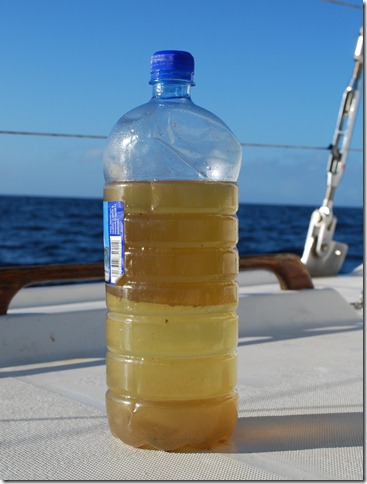 Filter contents: bottom half water, top half fuel (most of the fuel was from flushing, not the filter drain)
Filter contents: bottom half water, top half fuel (most of the fuel was from flushing, not the filter drain)
Within a couple of hours, the wind started to pick up a little bit and since then I’ve been doing 5-7+ knots on a beam reach with the full main and jib. The morning was clear again, warmer than yesterday, and the seas were pretty calm. This afternoon some low cloud cover rolled in, but the seas have stayed calm. I’ve sailed a course that’s almost 50 miles offshore now so that as the wind comes from the SSE and strengthens I’ll still have it aft of the beam as I near Cape Agulhas. It’s hard to say what my timing will be like at this point, but it looks like there will be a pretty good blow from the SE/SSE once I round the cape (I’ll be going NW then so should be fine), so I’m guessing I’ll make Simon’s Town in less than 48 hours.
Lat: 34 26.439′ S
Lon: 25 34.613′ E
All is well on board, just tired. The first 7 hours or so was pretty rough. I knew it was going to be quite a ride when I reached the harbor entrance and spotted the large pilothouse monohull that had left just before me. It was only about 0.5 nm ahead, but its AIS transmitter said it was making less than 2 knots and all I could see were its masts. The hull and considerable deckhouse were hidden below the waves. The next 7 hours or so was a full-on washing machine effect. Things came loose that hadn’t been on the floor for months, and the strong wind and big seas stayed forward of the beam. By sunset, things started to calm down a bit as the swell left over from yesterday’s blow started to subside and the wind gradually made its way back to the beam.
I did manage pretty good speed with a boost from the current, which just disappeared a couple of hours ago. So far, I’ve only been on the radio twice confirming that ships could see and avoid me. I was on the radio this morning at about 6 am when I noticed a strange sight off to starboard. I grabbed the binoculars and could see literally hundreds of dolphins breaking the surface as they chased and fed on what must have been a pretty large school of fish. Hundreds of birds swarmed overhead, swooping down in turns to grab a bite as well. At about 9:30 this morning, I was eyeing a large ship headed straight at me from ahead when a whale surfaced and blew so close to the bows that I could see the individual water drops and was afraid I might hit him. A minute or so later, the depth sounder went from reading too deep to return a value to sounding 100′ and then 40′ and then a few seconds later the whale surface again only 40′ or so off to starboard. Its big, wrinkled blowhole looked large enough to fit my head into, and its body was definitely larger than the boat. It’s deceiving how slowly they seem to be moving their massive bodies but how quickly they can appear, disappear, and maneuver out of the way of the boat (as long as they’re awake at least, they’re sometimes hit by sailboats while sleeping at the surface).
 Just a portion of the feeding frenzy
Just a portion of the feeding frenzy
It doesn’t seem like I’ve sailed that much farther south than Durban, but it’s definitely colder. Shoes, pants, and a sweater aren’t enough to stay warm at night. The sky finally cleared today, but even in bright sunlight it’s too cold to take my shirts off. I guess that’s a sign that it’s time to sail back toward the equator. It should be less than a day now before I reach the farthest point south in my planned course and turn north toward the cape and the Atlantic. It looks like the combination of good progress and good weather forecast will let me make Simon’s Town without stopping.
Well, the weather hasn’t quite been as expected, so I ended up spending a couple more nights here in East London, which has given me enough time to get some decent sleep, relax a bit, and fix the stove, which stopped working as soon as I tied up at the dock. I’d never really thought about it as a critical piece of gear, but it’s right up there with the autopilot, GPS, and head. The burner was lighting, but the flame wasn’t big enough to cook anything, or even to keep the safety thermocouple hot enough to keep the flow of propane on. All I had to do was clean the orifice, which was refreshingly accessible. I’ve taken a couple of afternoon runs and ventured into town once or twice.
My last run into town was to try to get a new battery for my Blackberry after I dropped mine in the water. I was trying to practice the guitar a bit (I think I decided tonight that I’m going to sell that thing when I get back to the US) while sitting on the trampoline and pulled out the Blackberry to look up a couple of chords. I managed to fumble it well enough that I both dropped it and pulled the battery cover open. It would have been no problem on the old tramps, but the new tramps have bigger openings, so the battery ended up dropping through. In the islands, that’s no problem, you can just spot it from the surface and then dive down and pick it up. A muddy, silted river mouth is another story altogether, however, and after a messy and futile diving experience in Durban, I didn’t even attempt to dive for it.
I stopped at one shop that had just closed, but they let me in and tried to help. They didn’t have the battery, but recommended an area of town that might and told me to walk over two blocks and catch a taxi. I was counseled to take the street to the north for the two block walk and not the street to the south as the street to the south was “very corrupt”. I was a little confused because I hadn’t seen a single taxi in town, but I walked to the appropriate corner and had a look around anyway. It quickly became apparent that there were no taxis as we’d think of them in the US. There were just private cars manned by “taxi drivers”. They just slow down and tap the horn if they see someone standing on the sidewalk to indicate that they’re a taxi and then there’s an exchange of finger signs, with the guy on the sidewalk holding up as many fingers as there are people in his party and the driver holding up a finger for each seat that’s still empty. The taxi I jumped into was like a small SUV with two bench seats and within a couple of blocks there were eight of us altogether.
My destination was a shopping mall that turned out to be like walking out of Africa directly into a nice suburban US mall. Malls aren’t exactly my favorite, but I generally end up there once a year about this time, so it seemed pretty fitting that I should find myself walking through the mall a couple of days before Christmas. In the end, it looks like I’ll be waiting for Lauren to come back and bring a battery, but I did meet a really nice Pakistani cell/electronics shop owner that actually drove me all the way back to the dock after closing his shop. I’d told him I was on a boat and he had lots of questions about the trip. Don’t let anyone tell you’re not going to meet nice people in South Africa.
Tomorrow is Christmas and it looks like I should be underway by noon. I’m hoping to sail all the way to Simon’s Town, False Bay, which is about 520 nm away and right across the peninsula from Cape Town. If I can do it in one run, it should take 3-4 days, but I’ll probably take a little different approach to this passage depending on how the weather looks. If the forecast stays the way it’s looked today, I’ll probably start near shore like I did last time, but then head a ways offshore to avoid a 12-hour bit of contrary winds near the cost on Monday, stay out of the shipping lanes, and avoid the coastal currents that can pull you into shore if you’re too close in and happen to fall asleep for too long.


